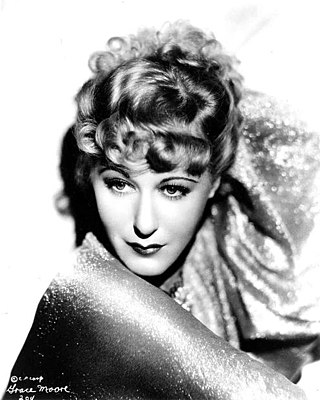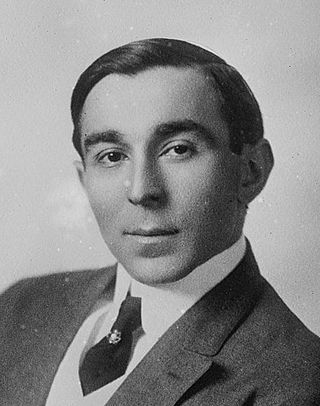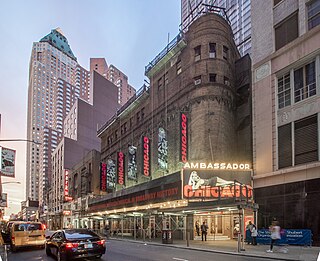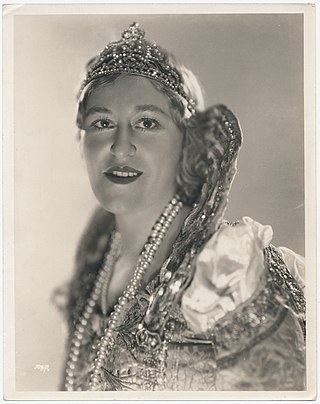Related Research Articles

Mary Willie Grace Moore was an American operatic lyric soprano and actress in musical theatre and film. She was nicknamed the "Tennessee Nightingale." Her films helped to popularize opera by bringing it to a larger audience. She was nominated for the Academy Award for Best Actress for her performance in One Night of Love.

Mary Ellis was an American actress and singer who spent most of her career in Britain. Trained as a lyric soprano, she began performing at the Metropolitan Opera where she created the role of Genovieffa in the world premiere of Giacomo Puccini's Suor Angelica in 1918. In 1924 she originated the title role in Rudolf Friml's operetta Rose-Marie at Broadway's Imperial Theatre. Other Broadway parts included Shakespeare roles such as Kate in The Taming of the Shrew.

Germaine Yvonne Arnaud was a French-born pianist, singer and actress, who was well known for her career in Britain, as well as her native land. After beginning a career as a concert pianist as a child, Arnaud acted in musical comedies. She switched to non-musical comedy and drama around 1920 and was one of the players in the second of the Aldwych farces, A Cuckoo in the Nest, a hit in 1925. She also had dramatic roles and made films in the 1930s and 1940s, and continued to act into the 1950s. She occasionally performed as a pianist later in her career. The Yvonne Arnaud Theatre was named in her memory in Guildford, Surrey.

The Shubert family was responsible for the establishment of Broadway theaters in New York City's Theater District, as the hub of the theatre industry in the United States. Through the Shubert Organization, founded by brothers Lee, Sam, and Jacob Shubert, they dominated the legitimate theatre and vaudeville in the first half of the 20th century.

The Broadway Theatre is a Broadway theater at 1681 Broadway in the Theater District of Midtown Manhattan in New York City. Opened in 1924, the theater was designed by Eugene De Rosa for Benjamin S. Moss, who originally operated the venue as a movie theater. It has approximately 1,763 seats across two levels and is operated by The Shubert Organization. The Broadway Theatre is one of the few Broadway theaters that is physically on Broadway.

The Ambassador Theatre is a Broadway theater at 219 West 49th Street in the Theater District of Midtown Manhattan in New York City. Opened in 1921, the Ambassador Theatre was designed by Herbert J. Krapp and was constructed for the Shubert brothers. It has 1,125 seats across two levels and is operated by The Shubert Organization. The auditorium interior is a New York City designated landmark.

Therese Gardella was an American performer on the stage and screen whose stage persona was Aunt Jemima. She was of Italian descent. She performed on both stage and screen, usually in blackface. Tess was born in Glen Lyon, Pennsylvania, to John and Louisa Gardella. She came to New York City in 1918, singing in dance halls and nightclubs and also political rallies.

Marta Eggerth was a Hungarian actress and singer from "The Silver Age of Operetta". Many of the 20th century's most famous operetta composers, including Franz Lehár, Fritz Kreisler, Robert Stolz, Oscar Straus, and Paul Abraham, composed works especially for her.

The Casino Theatre was a Broadway theatre located at 1404 Broadway and West 39th Street in New York City. Built in 1882, it was a leading presenter of mostly musicals and operettas until it closed in 1930.

Marguerite Sylva was a Belgian born mezzo-soprano who achieved fame in opera, operetta, and musical theatre. She was particularly known for her performances in the title role of Bizet's Carmen, which she sang over 300 times in the course of her career. Sylva was a pioneering recording artist for Edison Records and made many recordings for the company from 1910 to 1912.

Bertha Belmore was an English stage and film actress. Part of the Belmore family of British actors through her marriage to actor Herbert Belmore, she began her career as a child actress in British pantomimes and music hall variety acts. As a young adult she was one of the Belmore Sisters in variety entertainment before beginning a more serious acting career performing in classic plays by William Shakespeare with Ben Greet's Pastoral Players in a 1911 tour of the United States. She made her Broadway debut as Portia in Shakespeare's Julius Caesar in 1912. She returned to Broadway numerous times in mainly comedic character roles over the next 40 years, notably creating parts in the original Broadway productions of Lorenz Hart and Richard Rodgers's By Jupiter (1942) and Anita Loos's Gigi (1951). She worked in several productions mounted by Florenz Ziegfeld Jr., including appearing in the Ziegfeld Follies of 1925 with W.C. Fields and Will Rogers, and starring as Parthy Ann Hawks in the 1929 Australian tour and 1932 Broadway revival of Jerome Kern and Oscar Hammerstein II's Show Boat.

Annamary Dickey, also known as Annamary Dickey Laue, was an American soprano and actress in operas, operettas, musicals, night clubs, and concerts who had an active performance career from the 1930s through the 1960s. She began her career as a regular performer with the Chautauqua Opera and the St. Louis Municipal Opera in the mid to late 1930s. In 1939 she won the Metropolitan Opera Auditions of the Air which earned her a contract with the Metropolitan Opera (Met). She was a soprano in mainly secondary roles at the Met from 1939 to 1944; appearing in productions of Gluck's Orfeo ed Euridice, Massenet's Manon, Delibes' Lakmé, Charpentier's Louise, Bizet's Carmen, Der Rosenkavalier by Richard Strauss, Mozart's The Marriage of Figaro, and Smetana's The Bartered Bride. Her most significant role at the Met was as Musetta in Puccini's La bohème. A strikingly beautiful woman with a passion for fashionable clothes, she gained the moniker the "Glamour Girl of the 'Met'" and headlined a fashion campaign for Saks Fifth Avenue in 1945.

Patricia Bowman was an American ballerina, ballroom dancer, musical theatre actress, television personality, and dance teacher.
Lansing Hatfield was an American bass-baritone and radio personality who had an active performance career in operas, operettas, musicals, and concerts from mid 1930s until the late 1940s. He is best remembered for his frequent performances on American radio during the late 1930s and early 1940s, and two roles he created on Broadway: Daniel Webster in Douglas Moore's 1939 opera The Devil and Daniel Webster at the Martin Beck Theatre, and Reverend Alfred Davidson in Vernon Duke and Howard Dietz's 1944 musical Sadie Thompson at the Alvin Theatre. In 1941 he won the Metropolitan Opera Auditions of the Air, and was a resident artist at the Met from 1941 to 1944.

Grace Angelau was an American opera singer who had an active international career in operas and operettas in the 1920s, 1930s, and early 1940s. At various times in her career she was billed as a contralto and a soprano, but a 1942 article summarizing her career in Pix magazine labeled her as a mezzo-soprano. In the United States she appeared in operas in several theatres on Broadway, and was active with the touring San Carlo Opera Company, the Chicago Opera Company, and the New York Hippodrome Opera. She also appeared at European opera houses like La Scala, and at theaters in Australia, and Central and South America. She was particularly admired for her performances of Amneris in Giuseppe Verdi's Aida and Azucena in Verdi's Il trovatore. She owned and operated the Coonara Springs Restaurant & Gardens, now listed on the Victoria Heritage Database of historical sights, in Olinda, Victoria, Australia, during the 1940s. Many of her costumes, jewelry, photographs, and other personal artefacts are part of the Australian Performing Arts Collection at the Arts Centre Melbourne.

Colette D'Arville was a French soprano and musical theatre actress who had an international career in operas, concerts, and musicals from the 1920s through the 1940s. Born Marie Marthe Cescosse, she began her career at the Théâtre des Bouffes-Parisiens from 1922 to 1927 with the stage name Colette Etchery, she changed her stage name to Colette D'Arville for her United States debut in the 1928 Broadway musical Here's Howe. She was active with the Opéra-Comique in Paris during the 1930s, and periodically appeared in operas with American companies from 1931 to 1942 in addition to performing on American radio and in concerts and recitals. She was particularly associated with the title role in Bizet's Carmen. While principally active in live performance on the stage and radio, she starred as Chichita in the 1935 musical film Tango Bar for Paramount Pictures. She was romantically involved with composer Deems Taylor and tenor Giovanni Martinelli.
John R. Gurney was an American bass-baritone who had an active career as an opera, concert, vaudeville, and musical theatre performer from the 1920s through the 1940s. He was a principal artist at the Metropolitan Opera from 1936 through 1945 where he performed a total of 331 times. On the international stage he performed in operas at the Teatro Colón in Buenos Aires and the Theatro Municipal in Rio de Janeiro. He is best remembered for creating roles in the world premieres of Walter Damrosch's The Man Without a Country and Douglas Moore's The Devil and Daniel Webster. He recorded the role of Don Basilio in Rossini's The Barber of Seville which was released by RCA Camden in 1957. Gurney's son is racecar driver Dan Gurney.
Laurel Hurley was an American soprano who had an active performance career in the mid 20th century. She performed a diverse repertoire from musical theatre, operetta and opera; encompassing roles in the lyric soprano and coloratura soprano repertoire. While most often heard in works from the standard opera canon by composers like Mozart, Puccini, and Verdi, she was not afraid to tackle unusual works; performing in the United States premieres of Thomas Arne's Comus, Gluck's Paride ed Elena, and Darius Milhaud's Médée. Her performances and recordings in operas such as Bellini's La sonnambula and I Capuleti e i Montecchi, and Rossini's La Cenerentola and The Barber of Seville contributed to the Bel canto revival movement of the 1950s.

Jean Tennyson, also known by her married names Jean Tennyson Dreyfus and Jean Tennyson Boissevain, was an American soprano, musical theatre actress, philanthropist, and radio personality. She began her career performing in musicals and cabaret shows in Chicago; making her stage debut in 1919. She made her Broadway debut in the chorus of Albert Von Tilzer's 1923 musical Adrienne; ultimately taking over the title role four months into the shows run and performing that part on tour in 1924. After starring in the Broadway musical revue The Earl Carroll Vanities in 1928 and 1929, her career shifted towards opera and work as a concert soprano. She was a leading soprano in operas and concerts internationally from the 1930s through the 1940s, performing on the stages of opera houses like La Scala, La Fenice, the Vienna Volksoper, the Chicago Civic Opera and the San Francisco Opera.

Josepha Chekova, sometimes given as Josefa Chekova and also known by her married name Josepha Domansky, was a Czech-American soprano. She began her career in vaudeville as early as 1924, and was a contracted singer with WRNY radio in 1926–1927. After appearing in a musical revue in Chicago, she won a vocal competition in 1927 which provided her with a scholarship to train as an opera singer at the Bel Canto Studio, Inc. of New York. She later studied singing further in New York City with Estelle Liebling. She made her opera debut at the Prague State Opera prior to becoming a leading soprano with the New York Opera Company in 1933. She was a leading soprano at Radio City Music Hall in 1930s, and toured with the San Carlo Opera Company in 1935–1936. She worked regularly with the Steel Pier Opera Company in Atlantic City from the mid 1930s into the early 1940s, and also appeared as a guest artist with opera companies in Washington D.C., Cincinnati, and Chicago. From 1940 to 1942 she toured with Armand Bagarozy's Columbia Opera Company, and in 1948 she gave a concert tour of Czechoslovakia.
References
- ↑ Francis D. Perkins (May 22, 1937). ""Marouf" Sung In English, with Chamlee in Role; American Tenor Portrays Cobbler in Rabaud Opera Revived After 17 Years; Nancy McCord in Debut, Long Island Soprano in Her First Metropolitan Part". New York Herald Tribune .
- 1 2 3 "Maj. E.C. Fleming And Bride Now at Western Ranch". The Washington Post . 10 April 1942. p. 20.
- ↑ "Sembrich Pupils to Sing.: Her Proteges to Appear in Benefit Recital at Lake George". The New York Times . 23 August 1930. p. 12.
- ↑ "Listening-In". The Washington Post . 21 September 1923. p. 22.
- ↑ "8,000 Hear 'Carmen' Sung at Stadium: The American Opera Company, Eugene Ormandy Conductor, Welcomed in Excerpts. "Pagliacci" Is Also Given – Heat Forces Natalie Hall, Heroine of "Carmen," to Sing Her Last Duet From a Chair". The New York Times . 13 August 1929. p. 30.
- ↑ "American Company Delights in "Figaro" – Mme. Sembrich in Audience at Casino as Nancy McCord Scores in Her Role of Suzanna". The New York Times . January 11, 1930. p. 21.
- ↑ "Feminine Frills: Footlight Fashions". Billboard . Vol. 42, no. 7. February 15, 1930. p. 40.
- ↑ "Casino Theatre, Landmark, Passes: Playhouse That Opened 48 Years Ago Was Scene of Success of Many Celebrities – Once "Farthest North" – Francis Wilson Speaks After the Final Curtain – Commercial Structure to Rise on Site". The New York Times . 19 January 1930. p. 31.
- ↑ "Opera Singers Will Have Tea In Thrift Shop: Divas to Attend Affair In Costumes of Their Stage Roles". The Washington Post . 20 January 1930. p. 4.
- ↑ "'Faust,' 'Carmen' Close Opera Here: American Company Adds to Laurels in Presentation of Final Classics – Orchestra is Lauded". The Washington Post . 23 Jan 1930. p. 4.
- ↑ "The Stage: Bettina Hall in New Show". Billboard . Vol. 4, no. 48. November 29, 1930. p. 15.
- ↑ "New Operetta". Chicago Daily Tribune . 1 January 1933. p. SC5.
- ↑ Abel (August 9, 1932). "Vaudeville House Reviews: Equity Thought Revue, but Brown's 'Scrap Book' Is Vaudeville at $1". Variety . 107 (9): 29.
- ↑ Loop (July 24, 1934). "Variety House Reviews: PALACE, CHICAGO". Variety . 115 (6): 18.
- ↑ Burr, Eugene (August 13, 1932). "The New Plays on Broadway: Ambassador". Billboard . Vol. 44, no. 33. p. 19.
- 1 2 Jack Mehler (February 11, 1933). "The New Plays on Broadway: 44th Street". Billboard . Vol. 45, no. 6. p. 17.
- ↑ Paul Denis (February 10, 1934). "Legitimate: The New Plays on Broadway – Shubert". Billboard . Vol. 46, no. 6. p. 16.
- ↑ Ibee (December 11, 1935). "Legitimate: Plays on Broadway - May Wine". Variety. 120 (13): 62.
- ↑ Downes, Olin (19 May 1939). "World Premiere for Benet Opera; American Lyric Theatre, for Its Bow, Gives The Devil and Daniel Webster New England Folk Tale Music Is by Douglas Moore – Text in English Idiom of Time and Place". The New York Times . p. 29.
- ↑ "Programs of the Week: World's Fair Opera Continues". The New York Times . 14 May 1939. p. 136.
- 1 2 "Legitimate: Plays Out of Town - Beloved Rogue". Variety . 119 (6): 57. July 24, 1935.
- ↑ "8,800 in St. Louis Hail 'Beau Brummell': World Premiere of Tierney Work Reveals Tuneful Operetta, Full of Comedy". The New York Times . 9 August 1933. p. 20.
- ↑ "Legitimate: St. Louis Opera Draws Record 13,000 Opening". Variety . Vol. 111, no. 1. June 13, 1933. p. 45.
- ↑ "American Stage – Florodora". The Stage . No. 2, 730. July 27, 1933. p. 15.
- ↑ "Feature News: St.Louis Muny Op Plans Set". Billboard. Vol. 47, no. 23. June 8, 1935. p. 6.
- ↑ Cohen (October 9, 1935). "Legitimate: Plays Out of Town - Venus in Silk". Variety. 120 (4): 52, 62.
- ↑ Sahu (July 13, 1938). "Play Out of Town: Lost Waltz". Variety. 131 (5): 50.
- ↑ "Legitimate Grosses: 'Rose-Marie' Clicks in St. L Al Fresco Bow". Variety. 134 (13): 43. Jun 7, 1939.
- ↑ "Legitimate Grosses: St. L. Streamlined 'Katinka' Preems; 'Waltz' Big $33,000". Variety. 135 (3): 51. June 28, 1939.
- ↑ Downes, Olin (May 22, 1937). "'Marouf' Revival Delights Audience – Salvos of Applause Greet the English Version of 'Cobbler of Cairo' at Metropolitan - Work Is in Comedy Vain – Gradually Gains in Its Musical Strength – Chamlee and Nancy McCord in Leading Roles A Welcome Departure Weds Sultan's Daughter Best Part of Opera". The New York Times . p. 18.
- ↑ "Radio-Reviews: Follow-Up Comment". Variety. 126 (6): 35. April 21, 1937.
- ↑ "Shuberts Reviving Popular Musicals – ' Rio Rita' and 'The Mikado' to Follow Successful Run of 'Student Prince' in Boston". The New York Times . October 10, 1941. p. 27.
- ↑ Wood, Frank W. (July 19, 1941). "Legitimate: Dallas Ops Still Going Strong". Billboard. Vol. 53, no. 29. p. 16.
- ↑ "Obituary of Anna Marie "Nancy" (McCord) Fleming". Arcadia Tribune . 14 July 1974. p. 7.